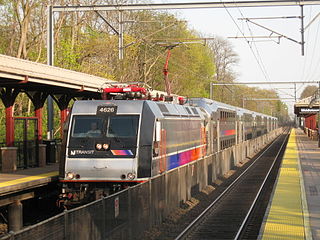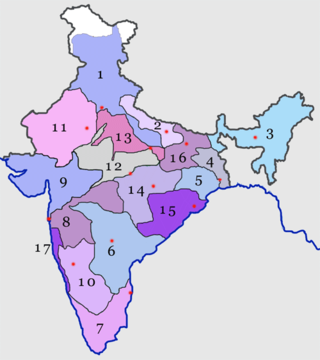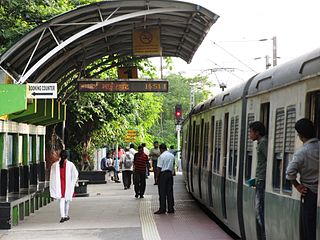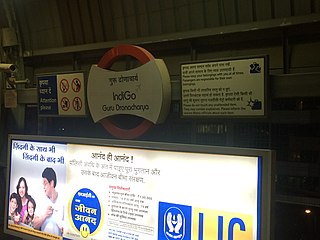
Commuter rail, or suburban rail, is a passenger rail transport service that primarily operates within a metropolitan area, connecting commuters to a central city from adjacent suburbs or commuter towns. Commuter rail systems are considered heavy rail, using electrified or diesel trains. Distance charges or zone pricing may be used.

The Mumbai Suburban Railway consists of exclusive inner suburban railway lines augmented by commuter rail on main lines serving outlying suburbs to serve the Mumbai Metropolitan Region. Spread over 390 kilometres (240 mi), the suburban railway operates 2,342 train services and carries more than 7.5 million commuters daily.

The Northern Railway (NR) is one of the 19 Railway zones of India and the northernmost zone of the Indian Railways. It is headquartered at Baroda House in New Delhi.

The National Capital Region (NCR) is a planning region centred upon the National Capital Territory (NCT) of Delhi in India. It encompasses Delhi and several districts surrounding it from the states of Haryana, Uttar Pradesh and Rajasthan. The NCR and the associated National Capital Region Planning Board (NCRPB) were created in 1985 to plan the development of the region and to evolve harmonized policies for the control of land-uses and development of infrastructure in the region. Prominent cities of NCR include Delhi, Faridabad, Ghaziabad, Gurugram, Noida and Meerut.

The Kolkata Suburban Railway is a suburban rail system serving the Kolkata metropolitan area and its surroundings in India. It is the largest suburban railway network in the country by number of stations and track length, and also one of the largest in the world. There are five main lines and nineteen branch lines. It operates more than 1,500 services, carrying 3.5 million people daily and 1.2 billion people every year. It runs from 03:00 am until 02:00 am and fares range from Rs.5 to Rs.25. The system uses 25 kV 50 Hz AC power supply and runs on 5 ft 6 in broad gauge track. It has interchange stations with the Kolkata Metro at various locations.

Delhi has significant reliance on its transport infrastructure. The city has developed a highly efficient public transport system with the introduction of the Delhi Metro, which is undergoing a rapid modernization and expansion since 2006. There are 16.6 million registered vehicles in the city as of 30 June 2014, which is the highest in the world among all cities, most of which do not follow any pollution emission norm, while the Delhi metropolitan region has 11.2 million vehicles. Delhi and NCR lose nearly 42 crore man-hours every month while commuting between home and office through public transport, due to the traffic congestion. Therefore, serious efforts, including a number of transport infrastructure projects, are under way to encourage usage of public transport in the city.
The Western Peripheral Expressway (WPE) or Kundli–Manesar–Palwal Expressway, is an operational 6-lane, 135.6 km (84.3 mi)-long Expressway in the Haryana state of India. Along with the Eastern Peripheral Expressway, the Western Peripheral Expressway is expected to divert more than 50,000 heavy vehicles away from Delhi, which will help to maintain good air quality in Delhi. Western Peripheral Expressway along with Eastern Peripheral Expressway completes the largest Ring Road around Delhi. There are 10 tolled entries and exits, from north to south - Kundli, Kharkhoda, Bahadurgarh, Badli, Fartukhnagar, Panchgaon, Manesar, Taoru, Sohna & Palwal. Toll rate notified in December 2018 is INR1.35 per km for cars, INR2.18 per km for light motor vehicles, INR4.98 per km for trucks and buses, and two wheelers are not permitted on the expressway.

Bengaluru Suburban Railway is an under construction suburban rail network for the city of Bangalore. A Suburban Rail system for the city was first proposed in 1983. Since then, several different route proposals were made but no Suburban Rail project took shape. It was finally approved in the 2019 Railway Budget.

Urban rail transit in India plays an important role in intracity transportation in the major cities which are highly populated. It consists of rapid transit, suburban rail, monorail and tram systems. According to a report published in 2021, a total of 2.63 billion people travelled annually in metro systems across India's sixteen major cities, placing the country as one of the busiest urban rapid transit hubs in the world in terms of ridership. The combined length of 895 kilometres of metro systems in India makes it the third longest in operation in the world.

The Millennium City Centre Gurugram is a terminal station on the Yellow Line of the Delhi Metro. It is an elevated station and is located in Gurgaon in the National Capital Region of India. The station was inaugurated on 21 June 2010 as part of the Qutab Minar—HUDA City Centre corridor.

The Guru Dronacharya metro station is located on the Yellow Line of the Delhi Metro.

The MG Road is a Delhi Metro station located in Gurgaon, Haryana. The station lies on the Yellow Line of the Delhi Metro.

The IFFCO Chowk metro station is located on the Yellow Line of the Delhi Metro.

The Delhi Metro is a mass rapid transit (MRT) system serving Delhi and its adjoining satellite cities such as Ghaziabad, Faridabad, Gurugram, Noida and Bahadurgarh, in the National Capital Region of India.
Kaushambi, a part of the planned industrial city of Ghaziabad, is an industrially planned and well developed region, under Vasundhara Zone of Ghaziabad Municipal Corporation. Situated at the sidelines of the Delhi-U.P. border, it provides quick access to the capital city. Although not large, the city holds a conglomerate of various facilities, such as a shopping complex, movie theaters, city parks, company offices, computer education, robotics training and housing societies. Being part of the most populous state of India, it receives a good number of visitors and locals. The incumbent Chief Minister of Delhi Arvind Kejriwal, resided in Girnar Apartments of Kaushambi before shifting to Delhi when Aam Aadmi Party won the 2015 Delhi Elections.

The Delhi–Meerut Regional Rapid Transit System, also called as Delhi–Meerut RRTS, is an 82.15 km (51.05 mi) long, rapid rail corridor that will connect Delhi, Ghaziabad and Meerut, currently under construction. It is one of the three rapid rail corridors planned under Phase I of the RapidX project managed by the National Capital Region Transport Corporation (NCRTC). With a maximum speed of 180 km/h (110 mph), the distance between Delhi and Meerut will be covered in less than 60 minutes. The project is being executed at a cost of ₹30,274 crore (US$3.8 billion). It will have 22 stations and two depots at Duhai and Modipuram.

Delhi–Alwar Regional Rapid Transit System is a 164 km long under-construction semi-high speed rail corridor connecting Delhi, Gurgaon, Rewari and Alwar. It is one of the three RapidX corridors planned under Phase-1 of the Rapid Rail Transport System of the National Capital Region Transport Corporation (NCRTC). With maximum speed of 160 km/h and average speed of 105 km/h, the distance between Delhi and Alwar will be covered in 104 minutes. The project is expected to cost ₹37,000 crores.

The rail network in the state of Haryana in India, is covered by five rail divisions under three rail zones: North Western Railway zone, Northern Railway zone and North Central Railway zone.
A multiple-unit train or simply multiple unit (MU) is a self-propelled train composed of one or more carriages joined together, which when coupled to another multiple unit can be controlled by a single driver, with multiple-unit train control. Although multiple units consist of several carriages, single self-propelled carriages, such as railbuses and trams – are in fact multiple-units when two or more of them are working connected through multiple-unit train control.

The RapidX is an elevated rapid rail system operated by the National Capital Region Transport Corporation (NCRTC) in India's National Capital Region (NCR). The goal of the RapidX is to replace the conventional non-air-conditioned MEMU-operated local train network with an elevated rapid rail system. The semi-high speed trainsets which are providing services on RapidX have been named as Namo Bharat and have an average speed of 100km/hr.





























